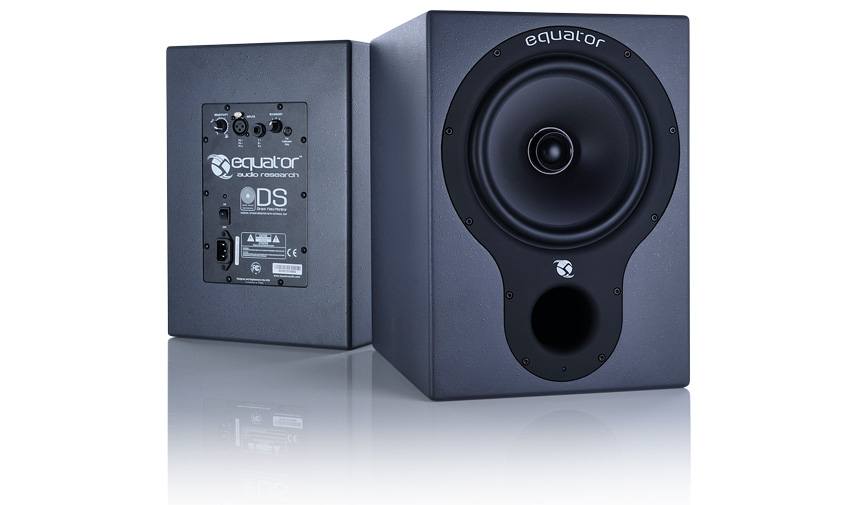MusicRadar Verdict
A well-balanced studio monitor with nicely focused imaging and midrange.
Pros
- +
Sharp imaging. Midrange detail. Voicing options.
Cons
- -
Not much.
MusicRadar's got your back
We took a look at the Equator D5 a little while ago and now the US company is back with some larger monitors which it says are designed specifically to deliver a much bigger sound while maintaining the D5's extreme level of detail.
The D8 offers the same design aesthetic as the D5 but has a larger 8-inch woofer, so the cabinet size has increased in proportion. While obviously not as compact as the dinky D5, the D8 is still of a size that wouldn't be out of place in a smaller room, although it is quite deep at around a foot front to back.
Tweeter in the middle
What you are buying into with the D8 is a coaxial design with the tweeter placed at the centre of the woofer, allowing the audio to emanate from a single point source. This should provide a more accurate midrange sound because there should be none of the phase distortion that can arise when sound waves generated from a separately located tweeter and woofer collide.
"The voicing of the speakers is carried out in consultation with top mix engineers, Equator's 'Technical Advisory Committee'"
Another design feature that Equator integrates into its D series is the use of internal DSP. There's a steep 4th order crossover along with a DSP-aided group delay filter designed to deliver a phase accurate detailed midrange with unobstructed clarity in the 900Hz-3kHz range plus matched output so each individual monitor is identical, ensuring that the stereo imaging will not be compromised by left and right having slightly different characteristics. The voicing of the speakers is carried out in consultation with top mix engineers, Equator's 'Technical Advisory Committee', who reference their own hit mixes in the process.
Each monitor in a pair is connected on the rear panel using an IEC (kettle) lead. Audio connections are via either XLR or 1/4-inch TRS jack, while a DIN socket is provided for factory calibration. The volume is set by a sensitivity knob, detented for accurate matching of your two boxes, while a three-way boundary position switch lets you optimise the monitor's response. This is normally some form of bass roll-off to compensate for wall or corner placements - corner, in front of a wall or freestanding.
What Equator has actually done with the switch is to give you a choice at position 1 of an appropriate bass roll off for a wall placement (2.5dB roll off from 1k down to 44Hz). Position 2 features a flat response with no bass roll off, while at position 3 Equator have included a voicing that they believe delivers exceptional midrange clarity featuring a bell type dip centred at 150Hz and a general rise starting at 6500Hz.
Hot D8
With 100W of power on tap and a max SPL of 106dB, the D8s have plenty in reserve if you want to pump things up, but using the monitors at a sensible sustainable listening level with a variety of source material, the flat position offers a fine balance with no obvious frequencies out of place.
The top end is smooth and the combination of the 8-inch woofer and the 2.5-inch port located on the front panel ensures that the bottom end is solid and deep enough to let you gauge what's going on down there. The DSP at the crossover point must be doing its job as the midrange detail is easily picked out.
Switching to position 3 offers a subtle difference, most apparent in a slight increase in the high end, and it's good to have that choice, if that's your preference. Stereo imaging is pinpoint and, when mixing, small adjustments on the pan pot are clearly apparent.
The D5s are a really good choice for a compact monitor but these bigger boxes take the concept and sound a stage further. Delivering a clear and detailed soundstage, these could be just what you need as the main monitor system in your studio.
Trevor Curwen has played guitar for several decades – he's also mimed it on the UK's Top of the Pops. Much of his working life, though, has been spent behind the mixing desk, during which time he has built up a solid collection of the guitars, amps and pedals needed to cover just about any studio session. He writes pedal reviews for Guitarist and has contributed to Total Guitar, MusicRadar and Future Music among others.
With its latest free update, Ableton has finally turned Note into the app I always wanted it to be
Technically capable, but struggle to make your tunes sound musical? 5 simple music theory hacks to make your tracks stand out
"Despite its size, it delivers impressive audio quality and premium functions as well as featuring a good selection of inspired sounds": Roland GO:Piano 88PX review











